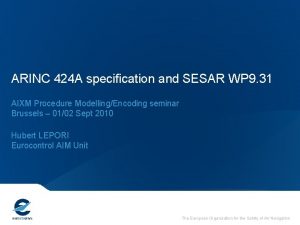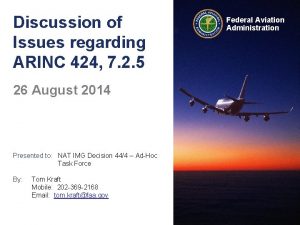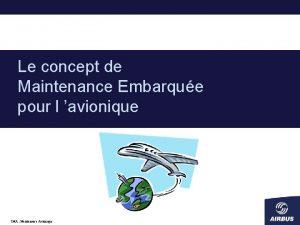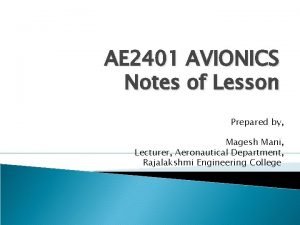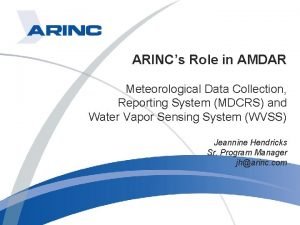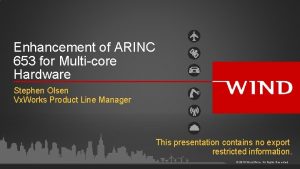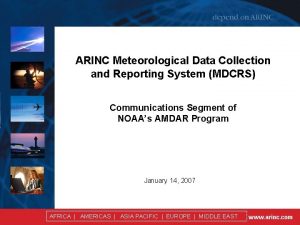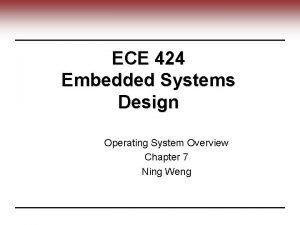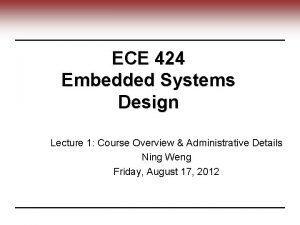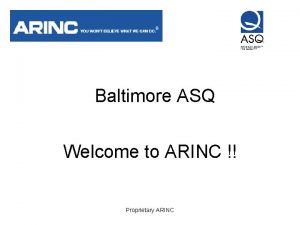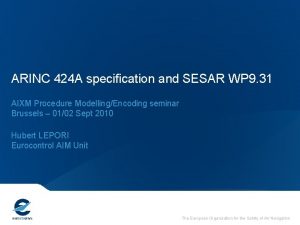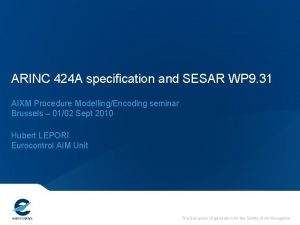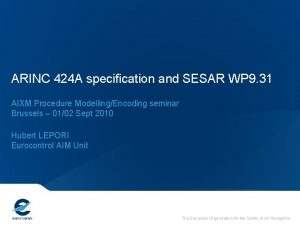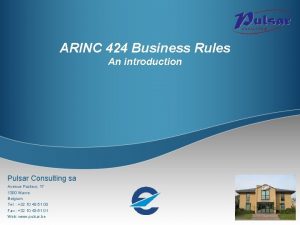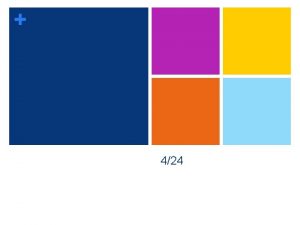Discussion of Issues regarding ARINC 424 7 2











- Slides: 11

Discussion of Issues regarding ARINC 424, 7. 2. 5 26 August 2014 Presented to: NAT IMG Decision 44/4 – Ad-Hoc Task Force By: Tom Kraft Mobile: 202 -369 -2168 Email: tom. kraft@faa. gov Federal Aviation Administration

Background (1 of 2) • April to May 2014 – NAT ANSPs reported increase in lateral deviations where aircraft began flying offsets one-half degree to the north of their cleared route – 3 Apr 2014 – navigation data base update added new half-degree waypoints using ARINC 424, 7. 2. 5; Operators were notified/unaware of change – Suspect incorrect ARINC 424, 7. 2. 5, fix name used; verification procedure not used or ineffective • 26 Apr 2014 – Gander (Nav. Canada) issued NOTAM to raise awareness of the issue (A 3151/14 refers) • Indication of lateral deviation was not obvious or readily detectable – Flight crew display of active route does not show lateral deviation; only achieved by verification of full coordinates for the waypoint using another pilot-selectable display – Controller can only detect lateral deviation using ADS-C or ATS surveillance service (e. g. radar); flight crew usually reported the position on the cleared route, not the actual aircraft position, which was incorrect ARINC 424, 7. 2. 5, Review 26 August 2014 Federal Aviation Administration 2

Background (2 of 2) • Before Apr 2014, if ARINC 424, 7. 2. 5, waypoint name entered incorrectly, flight crew would receive an error message – not in the data base • 29 May 2014 – New half-degree waypoints removed from data base • 16 May 2014 – NAT IMG Decision 44/4 – U. S. would coordinate, as necessary, to investigate issues with use of ARINC 424, 7. 2. 5, and recommend mitigations for consideration by the NAT SPG groups – Since May – U. S. has been coordinating via e. Mail and held three Web Ex meetings – Today – Ad-Hoc Task Force Web. Ex – To understand the issues with current ARINC 424, 7. 2. 5, naming convention and review proposed changes – 4 -5 Sep 2014 – Ad-Hoc Task Force Meeting (Paris) – to review and agree on a strategy for resolving issues with the use of half-degree waypoints – 22 -26 Sep 2014 – NAT CNSG/11 (Prestwick) – contributory group to the NAT IMG – 21 -23 Oct 2014 – related AEEC (ARINC 424) Standards Meeting (Tucson, AZ) – 4 -7 Nov 2014 – NAT IMG/45 (Paris) – contributory group to the NAT SPG ARINC 424, 7. 2. 5, Review 26 August 2014 Federal Aviation Administration 3

Purpose of ARINC 424, 7. 2. 5, review • To understand the issues with current ARINC 424, 7. 2. 5, naming convention and how its use contributes to potential lateral deviations • Review proposed revision to ARINC 424, 7. 2. 5 • Other perspectives to consider – Human factors – Global and ATC implications – Conflicts with other naming conventions and schemes for entering waypoints – Concept of use, flight crew procedures and training – Cost and timeline to implement the proposed solution • Contents of this presentation only represents work in progress and does not represent a position of the Ad-Hoc Task Force or any party ARINC 424, 7. 2. 5, Review 26 August 2014 Federal Aviation Administration 4

Current thinking • Operational trials of “half-degree” tracks are planned in the NAT Organized Track System in Nov 2015 • When using ARINC 424, 7. 2. 5, naming convention to routinely define ATC routes using half-degree waypoints, mitigation is needed to ensure an acceptable risk of lateral deviations • Procedures and training are essential to verify full coordinates of waypoints entered by the flight crew, but are NOT in and of themselves the solution to the problem • Other potential means to mitigate the risk of lateral deviations need to be considered. Including: – Loading route information directly from CPDLC clearances (but only if aircraft capable) – Using published waypoint names for half-degree waypoints – Entering full coordinates for waypoints ARINC 424, 7. 2. 5, Review 26 August 2014 Federal Aviation Administration 5

Current ARINC 424, 7. 2. 5, issues • Entering incorrect waypoint name can result in a small distance error (approximately 30 miles off of cleared route) that is not readily obvious to flight crew from displayed active route – 6230 N being 62°N 30°W – N 6230 being 62° 30’N 030°W • Placement of the four letters that signify cardinal direction (N, S, E and W) is the only discriminator for – Longitudes < or > 100° longitude – Whole and half-degrees latitude • Prefix/suffix confusion One mistake can cause error Waypoint name can conflict with lines of latitude or longitude in an ATC instruction, such as CROSS [line of latitude] at FL 350 – 6230 N being 62°N 30°W, per ARINC 424, 7. 2. 5 – 6230 N being 62° 30’N as [line of latitude] in ATC instruction ARINC 424, 7. 2. 5, Review 26 August 2014 Same name, but different meaning Federal Aviation Administration 6

ARINC 424, 7. 2. 5, Naming Convention Criteria 4 letters, same as used for cardinal direction 4 different letter placements Current Proposed Geographical coordinates for fix Latitude Longitude 8 letters, different from those used for cardinal direction xx° [00‘ or 30’] [N or S] [1]yy° [E or W] where xx = 2 integers where [1]yy = 2 or 3 representing degrees of integers representing the latitude degrees of longitude Core fix name convention format from source xx[1]yy Letter assignment for fix names Letter to use, if latitude 2 different letter placements Letter assignment for fix names Letter to use, if latitude Quadrant (See Notes) 00’ (Whole °) 30’ (Half °) Northwest N N Northwest A H Northeast E E Northeast B J Southeast S S Southeast C K Southwest W W Southwest D L Letter placement for fix names If fix latitude whole ° If fix latitude half ° then, if longitude > 100° < 100° xx[1]yy xxyy[suffix] x[Ltr]xyy [prefix]xxyy where the assigned letter replaces [1] replaces [suffix] replaces [Ltr] replaces [prefix] ARINC 424, 7. 2. 5, Review 26 August 2014 > 100° < 100° xxyy[suffix] [prefix]xxyy[suffix] where the assigned letter replaces [suffix] replaces [prefix] replaces [suffix] Federal Aviation Administration 7

Obviously LARGE – Distance Error – Unnoticeably SMALL Proposed Change to ARINC 424, 7. 2. 5, Naming Convention Current Quadrant Latitude Northwest (incl. NAT) 00° ≤ xx ≤ 89° 30’ Northeast 00° ≤ xx ≤ 89° 30’ Southeast 00° 30’ ≤ xx ≤ 89° 30’ Southwest 00° 30’ ≤ xx ≤ 89° 30’ North Pole 90° N 000° W [TBD] South Pole 90° S 000° W [TBD] Scheme Longitude Half Degree Whole Degree 001° < yy < 099° Hxxyy. A x. Nxyy xx. Nyy 100° < 1 yy < 179° xxyy. H Axxyy Nxxyy. N 000° < yy < 099° Jxxyy. B x. Exyy xx. Eyy 100° < 1 yy < 180° xxyy. J Bxxyy Exxyy. E 000° < yy < 099° Kxxyy. C x. Sxyy xx. Syy 100° < 1 yy < 180° xxyy. K Cxxyy Sxxyy. S 001° < yy < 099° Lxxyy. D x. Wxyy xx. Wyy 100° < 1 yy < 179° xxyy. L Dxxyy Wxxyy. W If fix located on Use letter assigned to PREFIX/SUFFIX – Placement – PREFIX/SUFFIX (ONLY) INFIX/MIDFIX Equator North quadrants 8 new characters – Letters – (4) direction letters Prime Meridian or 180 th meridian East quadrants No N, S, E, or W – eliminates risk of confusion with waypoint coordinates Note. — Current ARINC 424, 7. 2. 5, does not address fix names at Equator, Prime Meridian, 180 th meridian, North Pole and South Pole. ARINC 424, 7. 2. 5, Review 26 August 2014 Also, allows fewer placement perturbations Federal Aviation Administration 8

Discussion topics Topic What is the potential for flight crew errors? How would errors be detected and corrected? (trapped) What is the effect of uncorrected flight crew errors? What is the complexity of mental model needed to process the waypoints? Does the proposed naming scheme conflict with any other naming schemes or data entry conventions? Is the naming convention compatible with existing avionics and data bases? Does the naming convention yield a unique and unambiguous identifier for the fix? Can the naming convention be used to name fixes with whole or half-degree latitude and whole degree longitude anywhere on the globe? What is the effect on flight crew training and procedures? Can the naming convention be used by ATC – Is it compatible with existing systems? What would be the effect on air traffic controller training and procedures? ARINC 424, 7. 2. 5, Review 26 August 2014 Federal Aviation Administration 9

ARINC 424, 7. 2. 5, Review 26 August 2014 Federal Aviation Administration 10

Note: While shown, current ARINC 424 does not address duplicate names at Equator, Prime Meridian and 180 th meridian lines. Current ARINC 424, 7. 2. 5, Naming Convention NAT Region Northwest Latitude 90°N– 00°N 00° 30’S– 90°S Latitude Southwest Longitude 179°W-100°W 099°W-000°W x. Nxyy Nxxyy xx. Nyy xxyy. N xx. Wyy xxyy. W x. Wxyy Wxxyy 179°W-100°W 099°W-000°W Longitude 000°E-099°E 100°E-180°E Half Exxyy x. Exyy Whole xxyy. E xx. Eyy Whole Half xxyy. S xx. Syy Sxxyy x. Sxyy 000°E-099°E 100°E-180°E Longitude Northeast Latitude 90°N– 00°N 00° 30’S-90°S Latitude Southeast Proposed ARINC 424, 7. 2. 5, Naming Convention NAT Region Northwest Latitude 90°N-00°N 00° 30’S-90°S Latitude Southwest ARINC 424, 7. 2. 5, Review 26 August 2014 Longitude 179°W-100°W 099°W-000°W Hxxyy. H xxyy. A Axxyy. D Dxxyy Lxxyy. L 179°W-100°W 099°W-000°W Longitude 000°E-099°E 100°E-180°E Half xxyy. J Jxxyy Whole Bxxyy. B Whole Half Northeast Latitude 90°N-00°N Cxxyy. C xxyy. K Kxxyy 000°E-099°E 100°E-180°E Longitude 00° 30’S-90°S Latitude Federal Aviation Administration 11 Southeast
